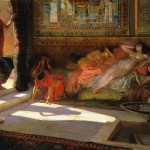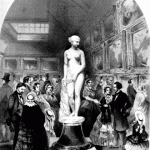A Fetlife post directed me to an entire page of Victorian paintings about slavery, or rather the Romanticized European view of slavery in “the Orient” or in ancient Rome, which was also a vehicle for female nudity. (Contrary to popular belief, Victorians had no problem with nudity if it was within the proper context.)
The page is in Turkish, but there’s little text anyway.
José Jiménez Aranda (Spanish , 1837-1903) – Una esclava en venta/ A Slave Sale
Ferencz-Franz Eisenhut (Hungarian Painter ,1857-1903) – Before the Punishment
Ernest Normand (French Painter, 1857-1923) – The Bitter Draught of Slavery
E.A Hofmann – Slave Market
As Bram Dijkstra pointed out in Idols of Perversity, these kind of paintings were displayed in mass exhibitions and seen by men, women and children of a broad range of social classes. They were also reproduced in miniature for home display or in magazines. So how were they seen?
Voyeurism is a strong element in these images, particularly the ones that depict slave markets and either include the potential master in the composition or put the viewer in the position of the potential master, assessing the offerings. Some depict the moment of revelation, when the slave woman is literally unveiled for the onlooker, both the leering Asian caricatures in the paintings and the people viewing the paintings.
Of course, despite the near-photographic detail, these images probably have very little to do with the reality and everything to do with “the Orient” as a space for sexual fantasy. Not just for men, I might add.







